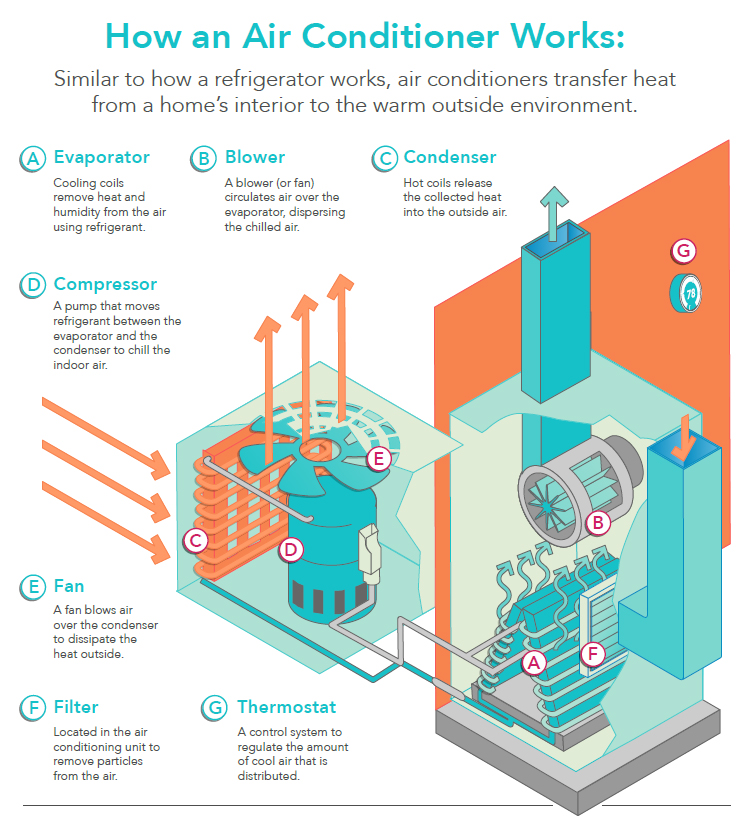WHAT IS CENTRAL AIR?
A typical air conditioning system, often referred to as “central air” or “split-system air conditioning”, normally includes the following:
- a thermostat that controls system operation
- an outdoor unit that houses a fan, condenser coil, and compressor
- an indoor unit (typically either a furnace or fan coil) that houses the evaporator coil and fan to circulate the cooled air
- copper tubing that allows the refrigerant to flow between the indoor and outdoor units
- an expansion valve that regulates the amount of refrigerant going into the evaporator coil
- ductwork that allows air to circulate from the indoor unit out to the various living spaces and back to the indoor unit
Central air conditioning system diagram
This is a Central air conditioning system diagram. It intuitively tells us the operating principle of central air conditioning.

In its most basic description, the air conditioning process involves two actions that occur simultaneously, one inside the home and one outside the home.
- Inside the home (sometimes referred to as the “cold side” of the system), warm indoor air is cooled as it blows across a cold cooling coil full of refrigerant. The heat from indoor air is absorbed into the refrigerant as the refrigerant turns from liquid to gas. The cooled air is distributed back to the house.
- Outside the home (sometimes referred to as the “hot side” of the system), the refrigerant gas is compressed before entering a large coil in the outdoor unit. Heat is released outside as the refrigerant turns back to a liquid and a large fan pulls outdoor air through the outdoor coil rejecting the heat absorbed from the house.
The result is a continuous cycle of heat and humidity being removed from indoor air, cool air returning to the home, and heat and humidity exiting the home.
How does ac work according to the central air conditioning system diagram
Now that you have a basic understanding of how air conditioners work, let’s dig a little deeper and describe the entire process works.
The thermostat, which is typically mounted on a wall in a central location within the home, monitors and controls the temperature of the indoor air. The cooling process starts when the thermostat senses the air temperature needs to be lowered and sends signals to the air conditioning system components both inside and outside the home to start running. The fan from the indoor unit pulls hot air from inside the house through return air ducts.
This air passes through filters where dust, lint, and other airborne particles are collected. The filtered, warm indoor air then passes over the cold evaporator coil. As the liquid refrigerant inside the evaporator coil converts to gas, heat from the indoor air is absorbed into the refrigerant, thus cooling the air as it passes over the coil. The indoor unit’s blower fan then pumps the chilled air back through the home’s ductwork out into the various living areas.
The refrigerant gas leaves the home through a copper tube and passes into the compressor in the air conditioner unit outside. Think of the compressor as a large electric pump. The compressor pressurizes the refrigerant gas and sends the refrigerant into the outdoor unit’s condenser coil. A large fan pulls outdoor air through the condenser coil, allowing the air to absorb heating energy from the home and release it outside.
During this process, the refrigerant is converted back to a liquid. It then travels through a copper tube back to the indoor unit where it passes through an expansion device, which regulates the flow of refrigerant into the evaporator coil. The cold refrigerant then absorbs more heat from the indoor air and the cycle continues.
If you think there are too many text descriptions, it doesn’t matter, you can watch the following video.
